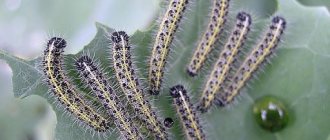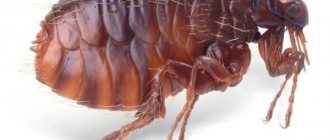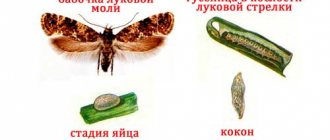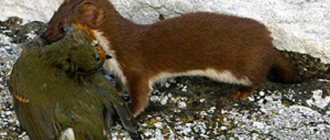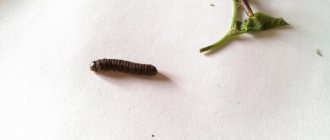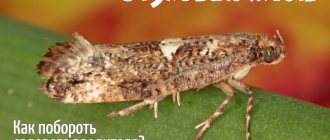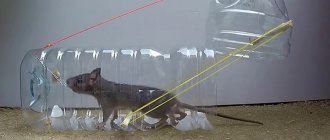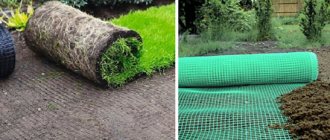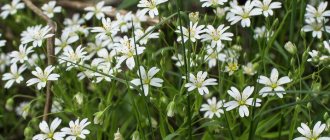AN EXCELLENT TOOL FOR CRAFTERS AND HANDCRAFTS AND EVERYTHING FOR THE GARDEN, HOME AND Cottage LITERALLY FOR FREE + THERE ARE REVIEWS.
This year we have some kind of misfortune in the garden.
Out of nowhere, a caterpillar appeared and ate all the leaves on the pear, quince, cherry and plum. We saw the same caterpillars in a forest plantation not far from our site. These caterpillars live in webs in many pieces and simply skeletonize trees. Tell me what kind of pest it is and how to fight it? Dmitry Gromov
Description of the pest
The insect is no more than 3.6 cm wide and 1.5 cm long; despite its miniature size and vulnerability, it has managed to spread to many regions of the globe.
The color of the wings is white, sometimes the wings are painted with black dots. Almost the entire body is covered with scales; there is some difference between males and females in the construction of antennae: males have feathery antennae, females have filamentous antennae, males have orange colored paws.
The female is distinguished by a greenish color of the abdomen before preparing to lay eggs. The eggs themselves are green, which is why they are so colored.
The eggs hatch into caterpillars, which then turn into butterflies. The caterpillar goes through about 7 periods until it turns into a butterfly. The initial length is up to 0.6 cm, the caterpillars live in colonies, and over time they grow.
By changing its age, the caterpillar partially changes its behavior; it becomes more independent.
Where did this pest come from?
This scourge came from North America, from where it began to rapidly spread across the globe. Two factors play in its favor: the insect’s excellent adaptation to almost any conditions and the people themselves. The white moth has no natural enemies; due to its numbers and rate of expansion (up to 40 km of new territory per year), it displaces native phytophagous pests.
People are guilty of their negligence. They abandon garden plots and vineyards, leave untreated growth along the roads and do not carry out any mass quarantine measures, creating ideal conditions for insect reproduction. This not very large white moth is capable of ruining many years of gardener’s work in just a year, not to mention free vegetation, without which people will have a hard time in the polluted areas of various cities.
Reproduction
The emergence of butterflies from pupae after wintering occurs in mid-spring, after an increase in
temperatures up to 10 degrees. At the same time, mating begins, as a result of which the female lays up to 1.5 thousand eggs. They are found in groups of up to 600 eggs on the inside of leaf blades.
Caterpillars subsequently emerge from them, causing damage to fruit plants. Before the cold weather, the larva pupates, settling for the winter in cracks of various buildings and fences, debris on the soil, in grass stems, and dry leaves under trees. The flight of overwintered adults is often timed to coincide with the flowering of apple trees.
Most often, during the summer period, two generations of insects manage to develop, and the females of the second are much more fertile than the first. They are capable of laying up to 2.5 thousand eggs. Flight of the second generation of insects occurs in the second half of July.
Have you noticed small white worms in the cherry fruits? This cherry fly has decided to feast on your harvest! The apple blossom beetle is a very dangerous pest, as it affects the plant even during the flowering period. Read the article on how to fight this insect.
Click beetles are a very large family of insects. What they eat and what they look like - you can find out about this and other equally interesting facts by following the link.
American white butterfly: a “white and fluffy” pest
One of the most dangerous insects for agriculture, the American white butterfly, which has a distinctive gluttony, does not at first glance look like an insidious pest. But, having gotten to know her better, it will become clear that such an enemy should not be underestimated, so as not to be left without a harvest. A set of measures to exterminate the butterfly will help cope with it if necessary. Fortunately, it doesn't happen very often.
Description of the insect
The American white butterfly is a quarantine pest whose Latin name is Hyphantria cunea. She belongs to the Ursa family. The taste preferences of the winged pest are quite extensive: according to biologists, the “menu” of butterfly caterpillars includes about 230 species of trees, shrubs and herbaceous plants. But they give preference to plantings in the garden - fruit crops. This is the reason for the great negative impact of the “American” on agriculture.
A quarantine pest is an organism that is absent from the territory of the state or is present on it in limited quantities, but causes harm to plants.
Judging by the name, it is easy to guess that the historical homeland of the American butterfly is North America, where it is distributed from Canada to Mexico. On the neighboring southern continent, the insect has chosen Colombia.
The American white butterfly does not look threatening
The spread of the butterfly throughout the Old World and Asia began in the middle of the last century, namely in 1949, when it was spotted in Yugoslavia. Very soon the real invasion of the American white butterfly began in Eurasia, because it partially spread from the Caspian Sea to the Atlantic. In 1952, the pest was discovered on the territory of Ukraine in Transcarpathia, and soon appeared in the southern regions of Russia and the Central Asian republics. Biologists note that the butterfly spreads around the world mainly when transporting goods, primarily with the harvest of berries and fruits. The pest also travels in vehicles, with containers and packaging material. If at the final destination there are favorable conditions for the American white butterfly, then it begins to multiply and destroy plants.
Appearance
The wingspan of male American butterflies is 2.5 cm–3 cm, which is smaller than that of females: in females this figure can reach 3.6 cm. Although this insect cannot be called large. The peculiarity of butterflies is the snow-white color of the wings and body. The latter has long pubescence, making the insect appear fluffy. Some individuals have a scattering of black or brown spots of small diameter on their wings. The antennae of the butterfly are black, with a slight whitish coating. In females they look like smooth threads, and in males they look like combs.
Female individuals that have not yet laid eggs have an abdomen with a green tint. It appears due to the transillumination of eggs.
The development phases look like this:
- The caterpillar of the American white butterfly, just born, is colored yellow. At the same time, the head, chest shield and legs are somewhat darker. On the surface of the back there are 2 rows of small black or yellow warts with black and white hairs, and on the sides there are 4 such rows.
- In the last stage, the caterpillar becomes brown in color. The warts on the back are black, on the sides of the body they are bright orange, with long dark hairs coming out of them. The length of the caterpillar's body is up to 4 cm.
- The pupa of the American butterfly is brown, located in a gray cocoon. The length is approximately 1.5 cm. The body ends with spines: their number is from 10 to 15 pieces.
A snow-white imago emerges from the pupa.
Life of a butterfly
The American butterfly waits out the winter as a chrysalis, finding shelter from the seasonal weather. She climbs into the cracks of houses, into cracks in the bark of trees, into broken branches and other suitable corners. The insect will come out of its hiding place only in the spring, when the apple trees begin to grow. The main activity of butterflies occurs in May and June. When it comes to the time of day, they prefer night, starting to fly after the sun sets over the horizon. After mating, females lay eggs on the underside of the leaves. In total, she can lay 1,500 eggs in her life. 2–3 weeks after the clutch is created, caterpillars appear. They will transform into a pupa in 30 to 50 days, while simultaneously eating plant leaves.
The duration of the development phases of the American butterfly directly depends on climatic conditions. The optimal air temperature is 20–25 °C and humidity 70–80%.
At the end of July and August, butterflies of the “summer generation” are born, which are very active in the morning and night hours. They differ from “spring” ones in their increased fertility: females lay 2,500 eggs, from which caterpillars hatch in September. The pupae remain hidden for the winter.
The American white butterfly typically produces two generations per year.
What harm does the American butterfly cause?
Biologists note that all plants damaged by the American white butterfly can be divided into 3 large groups:
- “Favorites”: apple, plum, cherry, quince, ash. They become victims of pests most often.
- Providing butterflies with a full cycle of transformation: deciduous (shrubs and trees).
- Unable to provide a full cycle: coniferous trees and grasses. They are attacked only by already grown caterpillars.
Thus, most plants grown by humans may be at risk.
The damage to plants caused by the American white butterfly is as follows:
- The destruction of plant leaves by caterpillars, which, of course, causes irreparable harm to it. Young caterpillars eat the fleshy part, rich in juice, leaving a kind of skeleton of veins. Grown-up individuals are able to cope with it without leaving a trace of the leaves. This process continues until autumn.
- The plant cannot develop normally. Its appearance suffers, and productivity is significantly reduced. If measures are not taken to combat the American white butterfly, it may even die.
- Caterpillars tend to live in colonies. Gathering in heaps, they entwine the branches of trees and bushes with cobwebs. When neglected, such a halo completely surrounds the plant.
- Plantings attacked by the American butterfly are very weak. They hardly survive frosts.
Of course, one cannot fail to mention the amazing speed of spread of the American butterfly. If it appears on the site, then soon all nearby areas in the area will become infected.
Ways to fight
How to deal with the American butterfly? There are a number of special measures that will indirectly help prevent the appearance of an uninvited guest or reduce its population:
- Quarantine measures: inspection of supplies, new seedlings, etc.
- Planting monitoring.
- Removing dead bark from trees, in which pest pupae can hide in anticipation of spring warmth.
- Destruction of excess and dry branches.
- Regular weeding of the area;
- Plowing the rows between trees and shrubs in the fall.
But these measures are more prevention than a way to combat. There are special remedies for the American butterfly that help destroy it and save fruit and berry crops.
Chemicals
American moth control products should be used with caution because they are toxic. It is very important to follow safety precautions. But these remedies show good results:
- "Antio";
- "Durbasan";
- "Zollon";
- "Metaphos";
- "Nitrafen";
- "Phosfamide."
You can also use systemic insecticides such as Aktara or Karate. They are applied to trees by spraying them with a garden sprayer before flowering, so as not to harm the future harvest.
It is necessary to treat not only the affected trees, but also all plants located within a radius of 50 m. The consumption rate is indicated in the instructions for each drug and depends on the concentration of active substances in it.
Other means
The most primitive way to destroy a butterfly is the mechanical collection of caterpillars. They are easy to spot on the leaves. It is more effective to do this at night or after it has rained, because at this time the caterpillars gather in flocks.
On an industrial scale, biological control methods are often used - the use of viruses and microorganisms that kill the American white butterfly.
You can also make traps from black hoses immersed at one end in a barrel of water. Caterpillars love moisture and warmth, and will certainly climb inside to pupate. Therefore, after 3 days it will be possible to destroy the prey.
An effective way to combat the American butterfly with folk remedies is a trap with beer or kvass. For caterpillars, such drinks are a treat. Therefore, if you hang a small container with a treat on a tree branch, after a few hours the pests will be trapped.
To exterminate a pest on your site, you need to use a set of measures. The use of folk remedies alone will not be enough. When the American white butterfly is driven out of the garden, it is necessary to constantly follow the rules of prevention.
beetlestop.ru
Maliciousness
Caterpillars of the American white butterfly The insect, a caterpillar of the described species, feeds first on the bark of trees, then on other plants. Older individuals are less demanding of the available food.
Under their influence, the bark of trees is damaged and leaves are destroyed. Plants lose their beauty and weaken under the negative influence of the environment. The tree may even die. As a result, the habitat of animals is narrowed, or at least the condition of the habitat deteriorates.
When the leaves are damaged, the yield decreases by more than 75%, which leads to the death of the crop; a person also suffers from direct contact; the caterpillar can cause an allergic reaction.
Literature
- Bulyginskaya M.A., Shamshev I.V. Sem. Arctiidae. / Insects and mites - pests of agricultural crops (ed. Kuznetsov V.I.). T. 3, part 2. Lepidoptera. St. Petersburg: Nauka, 1999. pp. 320-331.
- Vasiliev V.P., Livshits I.Z. Pests of fruit crops. M.: Kolos, 1984. 399 p.
- Shutova N.N., Smetnik A.I. Quarantine pests, plant diseases and weeds. / Plant quarantine in the USSR (ed. Shamonin A.I., Smetnik A.I.). M.: Agropomizdat, 1986. P. 143-248.
Wikimedia Foundation. 2010.
See what “American white butterfly” is in other dictionaries:
- Butterfly of the bear family, a quarantine pest of fruit crops in the North. America and Europe. The wings are snow-white, often with dark spots. Feeds (caterpillars) on leaves, entangles branches with a web ... Big Encyclopedic Dictionary
— (Hyphantria cunea) butterfly of the bear family. The wingspan is 20-35 mm, snow-white, often with dark spots. Caterpillar 25-35 mm long, velvety brown on top with black warts and long hairs, lemon yellow on the sides... ... Great Soviet Encyclopedia
American white butterfly
— Table 29. Pests of fruit and berry crops: 1 — common hawthorn (a — butterfly, b — caterpillar); 2 - gypsy moth (a - female, b - male, c - caterpillar); 3 - ringed silkworm (a - ... ... Agriculture. Large encyclopedic dictionary
A butterfly of the bear family, a quarantine pest of fruit crops in North America and Europe. The wings are snow-white, often with dark spots. Feeds (caterpillars) on leaves and entangles branches in a web. * * * AMERICAN WHITE BUTTERFLY AMERICAN... ... Encyclopedic Dictionary
Butterfly fam. bears, quarantine pest fruit. crops in the North America and Europe. The wings are snow-white, often with dark spots. Feeds (caterpillars) on leaves, entangles branches with a web... Natural history. encyclopedic Dictionary
AMERICAN WHITE BUTTERFLY
— (Hyphantria cunea), butterfly of the bear family, pest of many. (over 200) species of plants, especially mulberries and fruit trees. It entered Europe from the North. America in 1940, in the USSR in 1952 (Transcarpathian region). Object of external and internal quarantine. Wings in span... ... Agricultural encyclopedic dictionary
HYPHANTRIA CUNEA DRURY. — AMERICAN WHITE BUTTERFLY
— see Hyphantria cunea Drury. American white butterfly. A butterfly with a wingspan of about 40 mm. The head, chest, abdomen and wings are snow-white. The front wings are often with numerous or sparse black dots, the hind wings are plain white. Egg… …
HYPHANTRIA CUNEA DRURY - AMERICAN WHITE BUTTERFLY
- see Hyphantria cunea Drury American white butterfly. The quarantine object damages about 300 tree, shrub and herbaceous plants, and the preferred crops are mulberry, ash-leaved maple, and all fruit and ornamental crops. On... ...Insects - agricultural pests of the Far East
Goldfish “Butterfly” (calico variety) Jikin butterfly (Japanese ... Wikipedia
— “Shishi Gashira” on a 19th century postcard from the series “Goldfish in Japanese Culture” by Shinnosuke Matsubara... Wikipedia
This year we have some kind of misfortune in the garden. Out of nowhere, a caterpillar appeared and ate all the leaves on the pear, quince, cherry and plum. We saw the same caterpillars in a forest plantation not far from our site. These caterpillars live in webs in many pieces and simply skeletonize trees. Tell me what kind of pest it is and how to fight it?
Dmitry Gromov
Damage caused by meadow moths
Meadow moths belong to a group of particularly dangerous pests; they cause huge losses to agriculture. At the same time, both adult individuals and caterpillars at any stage of development are dangerous. Meadow moth butterflies feed on nectar and compete with honey bees. It has been noted that where there are a large number of meadow moths, the collection of honey in apiaries is noticeably reduced.
But the greatest damage is caused by voracious caterpillars. They eat plant seedlings at the initial stage of development, entwine them with webs and turn them into skeletons. Older caterpillars completely destroy all vegetation in their path, leaving only cuttings. A large colony of caterpillars can eat up the entire crop in a garden in a couple of days.
The diet of the voracious caterpillars of meadow moths consists of 200 plants. Favorite delicacies include sugar beets and weeds. With the same pleasure they destroy sunflowers, hops, corn, vegetables, buckwheat, alfalfa, millet, legumes and clover.
Pests also cause damage to young tree seedlings. If there are approximately 6 meadow moth caterpillars on a sugar beet seedling, the yield drops by 50-60%. If there are about 20 caterpillars, then the crops can be destroyed in a few days. And if the weather is hot, pests can destroy the planting in just a few hours.
Outbreaks of mass appearances of meadow moths occur approximately once every 8-10 years. A huge number of caterpillars can crawl from one area to another, and at the same time destroy everything that they come across. Favorable conditions for mass reproduction of meadow moths are sufficient rainfall and a temperature of about 17 degrees. If the weather is dry, the population of meadow moths decreases sharply, and the butterflies become infertile.
If you find an error, please select a piece of text and press Ctrl+Enter
.
Moths belong to the insect family Lepidoptera, or Butterflies. One of the main ways to tell a butterfly from a moth is to watch how they fold their wings when they sit down to rest. Butterflies usually keep their wings folded in an elevated position, while moths spread their wings horizontally. Butterflies usually flutter in the air during the daytime, and moths fly in the evening and at night. They strive for the light that burns in the night. Therefore, you can often see moths flying into the window and circling around the light bulb. Typically, moths have camouflage markings on the upper side of their wings, as these moths usually sit with their wings spread out. At night, protective colors do not really help the caterpillar or moth. There are other differences: in butterflies, the antennae usually have a thickening at the end, while in moths, the antennae are straight or even shaggy. In addition, the bodies of moths are thicker than those of butterflies and are more densely covered with hairs.
different types
You can often see it fluttering over the crops, flying from bed to bed. However, despite its beauty, the meadow moth should be feared.
In fact, it is a dangerous garden pest that damages potatoes and all kinds of vegetable crops.
The meadow moth lives in the steppes and forest-steppes of southern Russia, in the Crimea, all the way to the Far East. This butterfly has a grayish-brown color with dark brown spots and a yellow stripe along the outer edge; the wings below are light gray or dirty yellow.
When a butterfly sits quietly, its folded wings look like a triangle. Its caterpillars are greenish-gray in color, have a dark stripe along the back and several side stripes, and the head is black with a clear pattern.
Overwintering of caterpillars occurs in cocoons, in the surface layer of the earth. In spring, caterpillars pupate. Butterflies fly out of cocoons in the south with the onset of heat in late April - early May. In the central regions of Russia in the second and third ten days of May.
Where does he live?
As a habitat, individuals choose places protected from dampness and light. They can hide underground, use tree bark, and crevices. A village house with wooden buildings would be a very attractive place for them.
Insects also often hide in warehouses of vegetables and fruits. Often, once in a warehouse, the doll then ends up somewhere else.
The places they use for shelter are also a source of their further spread. This is helped by the ability to move far from the tree on which they lived, 25-30 meters.
What happens to the affected culture?
The leaf and branch on which the white night moth has laid eggs, after the appearance of the caterpillars, are slowly covered with viscous translucent threads, similar in appearance to a cobweb. Over time, entire colonies colonize the garden crop on the site, causing cocoons of cobwebs to form on the plant.
When severely damaged, trees do not overwinter well and often freeze out, causing them to lose their ability to bear fruit or die altogether. Everything is aggravated by the fact that after two months of parasitism on the plant, the caterpillars pupate again and in early August the white moth, the photo from which you see in the article, goes in a second wave to garden crops that have already been damaged and not yet affected by the pest.
How to feed butterflies
The insects themselves cannot see and fly up to the treat. If the taste buds have not worked, then it is recommended to help them. Take a toothpick and slowly spin the proboscis with it, pointing it towards the food. There is no point in holding the butterfly. During feeding, you can see the proboscis moving more intensely. After the insect has eaten, it simply flies away.
To the question “What do butterflies eat?” one could answer briefly - nectar. They love the nectar produced by various beautiful flowers. Moreover, unlike many insects, butterflies distinguish the color red, which allows them to better navigate in search of food.
And in today’s article we will talk in detail about what butterflies eat at home and how they survive in the wild.
How to fight?
So far, there are 2 areas of struggle:
- Use of chemicals;
- Inspection of the area where the pest is believed to be located and its destruction.
The second method is suitable if the area of the site is small, when it is possible to conduct a survey.
The examination is carried out at least once a week; it is not difficult to identify problem leaves: they darken, their edges curl up, as if they are drying up.
It is better to carry out removal in the late afternoon, before dark, by which time the insects gather in their nests. By removing a few leaves, you can get rid of an entire colony. The problem should be solved immediately, before the caterpillars turn into butterflies.
Different preparations are required, depending on what type of plant it is used on and what the characteristics of the soil are.
For example , drugs containing a virus that cause granulosis and nuclear polyhedrosis are used. Their value lies in the fact that insects, in contact with other individuals, spread the disease. Approximately 1/3 of the population dies, the remaining part behaves sluggishly, and the harm from it decreases. In addition, the virus is transmitted to offspring, which encourages developers, because it inhibits the spread of insects.
What can be said about chemicals? Their list is huge, some are suitable for getting rid of various parasites and unwanted guests, others are aimed exclusively against the white butterfly:
- Chlorophos;
- Entobacterin;
- Sevin;
- Rogor;
- Pirinex 40;
- Karbofos;
- Zolon;
- Antio.
Karfbofos, for example, acts on different types of pests, its effect is universal. Antio is also a powerful drug, but its use is harmful to both pets and people.
Research continues, with their help agronomists hope to learn about the pest’s weak points and develop more effective methods.
The problem remains of balancing the use of chemicals and maintaining the purity of products from chemical exposure. It's no secret that insecticides affect people and animals. The presence of chemicals cannot in principle be called normal. After getting rid of an insect, you can become poisoned by the fruits of a tree or plant.
Why are white moths dangerous?
In addition, the pest can be deceived by hanging pieces of fabric or burlap between the branches. Usually caterpillars readily peck at such bait. Therefore, when the time comes, it will be enough to remove the tissue with the pupated pest and burn it.
You can also try to catch the moth using light traps or paint the branches and trunk of the tree with water-based horticultural paint, sold in specialty stores. Timely cleaning of dead bark and skeletal branches will help make the search for the pest easier.
In some cases, the use of chemicals is encouraged. Experienced gardeners advise using preparations such as “Marshal”, “Molniya” (toxic to other insects, bee owners should be careful with it) and “Aktofit”.
In addition, in the fight against American moth caterpillars, insecticides against codling moths, for example, “Lepidocip”, “Akarin” or “Fitoverm”, are effective, since the treatment periods for these pests are the same.
It is customary to carry out four sprayings per year:
- during the period of moth flight and egg laying, i.e. approximately after the apple tree blossoms;
- approximately two weeks after the first treatment, at the time the caterpillars appear;
- after another two weeks, a third spraying is carried out;
- the fourth treatment occurs in mid-September; no chemicals are used until next year.
If necessary, you can use the above methods or collect the caterpillars by hand and burn them. However, after the pest has been on the garden crop, it would be useful to feed the plant with vitamins or other additives to ensure a good wintering and harvest for the next year.
You should not hesitate to take action, as such delays can be fatal.
Meadow moth: photo, description, methods of fight
Like every gardener, I greeted with shudder the first news from neighbors about the emergence of terrible pests from wintering - the Colorado potato beetles. That was until the meadow moth decided to meet me. Meadow moth The name is pleasant, it sounds tender and soft, like meadow grass, meadow hay, games on the lawn. And even from the first grade, the butterfly gives pleasant associations with childhood joy: “Look! The moth is flying! This deceptive pleasantness turned out to be disastrous for many of my fellow villagers. The meadow moth is much more dangerous than the Colorado potato beetle. The beetles fly during the day and hide in the soil at night. The meadow moth flies only at night. The butterfly flaps its wings 20-26 mm, that is, it is large and easy to notice. One problem is that a man sleeps at night, but a butterfly flies. Even in the light of a lamp, even though it hangs on the street, 2, 3 moths will fly in. And the rest are busy - laying eggs. Meadow moth eggs are difficult to see. They are small and blend in with the leaf. The caterpillar is born so tiny that it can only be seen with a magnifying glass; its color camouflages it. The first sign of a pest is a small cobweb that seems to glue the tender carrot leaves together.
Meadow moth eggs and caterpillars. Photo from the site greekbutterfliesmoths.files.wordpress.com At this time, it is imperative to treat with chemicals. After all, the appearance of the meadow moth is like a natural disaster when the media reports a storm warning. Because the caterpillar grows very quickly. From almost invisible, it soon turns into a worm 35 mm long. Meadow moth caterpillars grow very quickly. Photo from the site animalreader.ru And the caterpillars do not complain about their appetite. If 5 caterpillars are planted on a tomato bush in the morning, then in the evening there will be no bush. It's good if only the trunk remains. Once this happened to those fellow villagers whose vegetable gardens were located not far from the field. In the evening we watered the cucumber holes, onion beds, and beet shoots, then drank tea and talked about the prospects for the harvest and the weather. And in the morning, instead of green beds in the garden, there was only black earth. State of shock and complete lack of understanding of what happened: what happened? Who did so much harm? It was the work of a meadow moth. In a normal summer it only has two generations, and this is not an epidemic. But there are also years of mass emergence - this is where moths can destroy crops in large fields. Meadow moths. Photo from the site pelion-agro.com.ua In hot summers there may be more generations. In this case, one should rejoice in the very intense heat when a person suffers from the heat. The moth, it turns out, also suffers - its eggs become infertile. The butterfly itself does not cause any harm - it feeds on the nectar of flowers. A moth butterfly feeds on the nectar of flowers. Photo from blogs.amur.info The larva of the meadow moth is omnivorous. While garden vegetable crops are just sprouting, in the spring the moth lays eggs on wild ones. Everything suits him: quinoa and alfalfa. Then the caterpillars will move to more tasty leaves, because these tiny little runners can jump. The meadow moth is a very dangerous pest. Photo from the site obj.altapress.ru The larva of the meadow moth eats crops of carrots, oats, wheat, potatoes, onions, cucumber vines and leaves with equal appetite. Mowing the grass around the area does not work because the meadow moth is able to feed on old dry grass. Of course, the food supply after mowing is significantly reduced. Especially if everything is done on time and the dried grass is burned. Trichogramma eggs help well. But where can I get it? I've never heard of the local plant protection station selling it. Trichogramma. Photo from the site i.mycdn.me
Biological products based on Bacillus thuringiensis help cope with caterpillars. The fight must begin as early as possible, otherwise, while the drug helps clear the beds of larvae, they will have time to do a fair amount of damage. Treatment with these drugs is carried out when there is a massive migration of butterflies. At night, the places where they are located are discovered, and these places are treated with a biological product.
Ordinary chemicals help, but the concentration to kill a moth must be several times greater than to kill a Colorado potato beetle larva. And treatments can be proactive. It is necessary to spray not only the beds with vegetables and potatoes, but all adjacent areas where grass grows: lawns, garden rows, the sides of the driveway, and so on. In the fight against the meadow moth, you cannot hesitate. Photo from farm4.staticflickr.com
If you see notices on the doors of shops or bus stops about the invasion of meadow moths, you need to carry out treatment that same evening. Otherwise it may be too late.
The article is posted in the sections: garden and vegetable garden, pests, meadow moth, control, prevention, articles
3 thanks for article 1 favorites
7dach.ru
Folk methods of struggle
Folk remedies are sometimes more practical and cheaper than those offered by official science.
For example , barrels of water are placed under a diseased tree, and hoses are placed on the water. Pests attracted by moisture will climb into the hoses and remain there. Next, all that remains is to destroy the individuals caught in the trap.
container of kvass is made into a trap ; it is very attractive to this type of pest, and they can be pulled out and destroyed from there.
The remedies described are good if you monitor the appearance of the parasite from the very beginning, in the spring, when the weather is already quite warm. It’s easy to notice uninvited guests - look for leaves that have darkened and curled. Having discovered such a leaf, it is advisable to separate it from the branch, and destroy everyone who is in it by crushing it.
Thus, the white American butterfly is a serious pest that destroys various trees, plants, and directly harms humans. The pest is distributed on different continents, withstands bad weather well and easily moves from one place to another.
The main damage is caused by being a caterpillar before turning into a butterfly. To combat it, biological agents (viruses), chemical and folk remedies are used, limiting the use of chemicals or completely eliminating them. A variety of products helps to take into account the specifics of the land and the presence of domestic animals, and to avoid poisoning of animals and humans.
Why are white moths dangerous?
To combat the American white butterfly in individual areas in the fall, the soil is dug up, spider nests are collected and destroyed, trees are cleared of old bark and whitened with lime. The following bacterial preparations are used for pest control: dendrobacillin, bitoxibacillin, lepidocide. Spraying with aqueous suspensions of these drugs is carried out twice, at intervals of 7 days.
Here is an interesting method for collecting the American white butterfly, recognized as an invention by the State Scientific and Technical Expertise. To do this, you need to take standard metal barrels with a capacity of 200 liters each and place them at a distance of 10 m from one another. Fill the barrels with water and place pieces of black rubber hoses 1.2-1.5 m long on top of the edges of the neck, 5 pieces per barrel.
The barrels must be on the ground so that it is convenient for the caterpillars to “enter”. In hot weather, they crawl to the barrels, apparently attracted by the increased evaporation of moisture, climb onto them, and then, in search of optimal places for pupation, they are guided through hoses and penetrate inside. There they most often pupate on the third day.
Diet of domestic butterflies
They are often kept as pets. Moreover, keeping butterflies is not such a difficult task if you raise an omnivorous insect. Certain species of butterflies are very picky eaters and feed on certain nectar from certain plants. These pets are not suitable for home keeping.
In summer, insects can be fed with flower leaves, pollen, etc. But in winter they will have to prepare nectar. To do this you will need the following ingredients:
- 2 tsp. water;
- 1/5 tsp. honey
Take a container and pour water into it. Add honey and stir everything thoroughly. We feed this solution to insects.
You can also make pastes from fruits such as bananas, apples, oranges, pears, etc.
Control
Autumn parasites cause relatively little economic damage to forests,
but can cause significant cosmetic damage to fruit and ornamental trees.
American moth caterpillar colonies are limited to individual branches, making pruning and destruction a viable option in many
cases. However, this is difficult to do in tall trees.
You can often control the parasite by breaking it up with a rake or a strong stream of water from a garden hose. To minimize infestation, spider webs should be destroyed while the caterpillars are still small.
On small trees, web tents can be removed by hand or cut down and destroyed. For heavy infestations, spray thoroughly with pesticides labeled for use against caterpillars, which include carbaryl, diazinon or acetate as soon as small caterpillars are visible, this will stop the growth of caterpillars and their nests.
Adding soap or some other surfactant that can provide better wetting to the silk tent should improve control.
Although American moth caterpillar infestations are rarely serious, it is always important to keep your trees healthy. Water the trees in your yard during dry periods, and avoid injuring the trees or compacting the soil within their drip line. Keeping your trees healthy will help your trees recover from defoliation and other stresses and maintain their appearance year-round.
Beautiful and unusual entomofauna of the peninsula
The most beautiful insects in Crimea live not only in protected areas. Unusual specimens are found in parks, squares and even in private plots.
- Scolia giant wasp. The species is on the verge of extinction and is therefore listed in the Red Book. The size of the female reaches 5.5 cm. Against the background of a black body, wide purple wings and a bright yellow sternum look impressive. The entire body is covered with black and red hairs. The insect not only has beautiful bright colors, but also an extraordinary lifestyle. Scolia larvae parasitize the larvae of rhinoceros beetles, as well as beetles. The insect builds numerous tunnels in the soil, looks for a victim, paralyzes it and lays one egg at a time. So the offspring of Scolia do not experience a lack of nutrients, gradually eating away the insides of the host, consuming vital organs only at the end. Giant scolia are not only a decoration of the Crimean entomofauna, but are also among the largest insects in Crimea.
- The Xylocopa is a solitary hunter bee, often called the purple bumblebee because of its coloration. The size of the insect reaches 3 cm. The body is black metallic, densely covered with black hairs, decorated with small transparent wings with a purple tint. It does not have an aggressive disposition; it ignores human presence.
- The largest butterflies in Crimea are the Saturnia pear, also known as the peacock-eye, with a wingspan of 15 cm, swallowtails with a wingspan of up to 95 mm, podalirium, which has a wingspan of 7.2 cm, and polyxena (wingspan of 5.4 cm). In addition to their size, butterflies are distinguished by the original pattern on their wings. Seeing polyxena is very rare, as the species is on the verge of extinction. Only 4 species of vines serve as food sources for the caterpillars of this butterfly.
- Several species of hawkmoth butterflies have been preserved in Crimea: oak, oleander, etc. Occasionally, a rare species is found - the Death's Head. The individual is notable for having a pattern on its chest that resembles a human skull. The Death's Head caterpillar is also characterized by a memorable appearance - bright yellow, yellow-blue, yellow-lemon with blue oblique stripes. At all stages of development, hawk moths of this species are capable of making sounds.
Insects of Crimea
- Mantises. The size of individuals reaches 7.5 cm in the female. Males are somewhat smaller. The color depends on the surrounding vegetation and varies from brown to green shades. There is also a rare, unusual species of praying mantis in Crimea - the striped empusa. The insect is difficult to see, despite the fact that it reaches 6.5 cm in length. The body of the mantis is so thin that it looks more like a stick or a blade of grass.
- The Crimean ground beetle is one of the most beautiful beetles in Crimea. Color green, blue tones. The coarse-grained covering of the body creates an optical illusion that the insect changes its color and shimmers in different shades.
- Grasshopper Akrid. The harmless insect captivates with its size. Females grow up to 8 cm.
- Speaking about the insects of Crimea, one cannot help but recall the night singers - cicadas. Unlike crickets, their singing can only be heard during the daytime. Only males are endowed with singing abilities. The females are silent.
- Rhinoceros beetle. A rather rare specimen, which leads to a reduction in the number of Scolia. Only males have a horn. Insects grow up to 5cm. The shell appears varnished, long legs protrude from under it, and the abdomen is densely covered with hairs. The larvae of the rhinoceros beetle are very similar in appearance to the larvae of the cockchafer, which is why they are often destroyed.
- Stag beetle. No less beautiful than a rhinoceros. It is smaller in size than its fellow giants from Europe. Females also lack horns. Rarely found in mountain forests. Red Book insect.
- The dragonflies of Crimea deserve special attention. Entomologists have studied 60 species of these insects. All of them are predators and amaze with their variety of colors. Among the large specimens, the most notable are the large rocker, the lattice dragonfly with blue wings, and the emperor's watchman.
A description of all the insects of Crimea would not fit in a multi-volume encyclopedia. Entomologists have been studying them for more than 200 years, but more and more new species are still being discovered.
The sense organs of butterflies are presented as follows:
- Olfactory organs : in a moth they are outgrowths shaped like a cone or a wedge. Around them there are a number of sensory cells that lie in the deep layers of the skin and connect to the nerves responsible for sensory functions. Butterflies' sense of smell is quite acute, and it is thanks to it that they find males, females or food.
- Hearing organs : some individuals are distinguished by the presence of tympanic organs, which are absent in diurnal moths. Receptors of this type are located on the abdomen or back of the sternum, in special lateral recesses, which are covered with a cuticular membrane (underneath there is a trachea). Sound waves that travel through the air cause the membrane to vibrate, causing cells to be excited and information to be transmitted through sensors.
- Organs of vision : moths have two faceted eyes that occupy the main surface of the head. These organs of vision have the same structure as those of other insects: they consist of many small elements, including the lens, retina and innervation. As a rule, moths see much better up close than at a distance. The organs of vision of moths are designed, first of all, to detect oncoming movement and move in space themselves.
The eyes of butterflies are designed in such a way that they perceive all information separately. Therefore, the insect receives a mosaic image as output, which enlarges the real image of the object several times.
Eye structure
Description and appearance
The family of moths is very numerous and includes many species. In essence, a moth is the same butterfly, but nocturnal individuals differ from daytime ones in the time they are awake and slightly in their appearance.
Night butterflies have a massive, dense body, which is abundantly covered with villi, while day butterflies have a more slender, elongated body, and there are noticeably fewer villi. The moth's head is round, containing eyes, a proboscis (sometimes atrophied), and antennae (usually feathery or filamentous). There are three pairs of legs on the chest. Two pairs of wings, with the upper ones noticeably better developed. You can distinguish a night moth by the color of its wings - it is duller, inconspicuous, and dark shades predominate.
Butterfly
Parasitic butterflies that appear in cereals
The larvae of food Indian moths, granary moths and flour moths often settle in household cereal stocks. Externally, the moths resemble ordinary clothes moths, which eat woolen items. Over the course of 2 weeks, the female lays about 500 small eggs. After a few weeks, grayish-white larvae emerge from them, feeding on cereals.
Advice! A moth-infested product can be brought from a supermarket, because the larvae easily eat through cardboard and paper packaging. When cleaning kitchen cabinets, use a vacuum cleaner that will pull out moths even from deep cracks. Treat dishes and cereal containers with a vinegar solution. Sticky pheromone traps can be placed on slower male moths.
What harm does it cause to plants?
This polyphagous pest causes damage to more than 200 species of fruit trees and shrubs. He is especially popular with:
- mulberry;
- nut;
- Apple tree;
- pear;
- plum;
- cherry;
- cherries;
- quince;
- apricot;
- peach;
- rose hip.
The damage to trees caused by the butterfly is that:
- Only the newly hatched caterpillars immediately begin to eat the fleshy part of the leaf, leaving only a skeleton of veins. Older individuals eat the entire leaf.
- In the process of life, living in colonies, they form a nest, entwining entire branches, or even the entire tree, with cobwebs.
- The second generation of caterpillars, which is even more numerous, eats fruit crops until autumn.
- Another danger is that these lepidopterans are spreading around the world at tremendous speed, destroying an increasing number of green spaces. And they do this not thanks to their small wings, but by moving in packaging containers, in planting material, in boxes of fruit.
On trees damaged by caterpillars, wood growth slows down.
Metabolic processes in plants are disrupted and protective functions are weakened. As a result of damage, trees may not tolerate frost and die or produce poor yields for several years.
7) King Walnut Moth
Royal walnut moth (lat. Citheronia regalis), also known as royal citheronia. These insects are common in southern North America and have also been seen in the New York area. They do not boast the largest wingspan (only 10 centimeters), but by weight they are considered the largest moths in northern Mexico.
Reasons for appearance
Many people wonder where food moths come from in a house where regular cleaning is carried out. She cannot accidentally get into the apartment from the street, since she is not capable of flying that well. Those butterflies that flutter indoors are males. Female moths move much more slowly, mostly hopping from place to place. Therefore, even if a male individual has flown into a dwelling, it will not be able to reproduce without a female one.
Inside the bags there are already eggs or moth caterpillars, which then spread throughout the apartment. They get there through cuts, tears, punctures in the packaging or during packaging of goods at the factory.
Comfortable conditions for the reproduction of food moths are a temperature of 22...25°C and air humidity above 60%.
Harm to plants
Due to its large numbers, strong fertility, polyphagism and the development of at least two generations per season, the American white butterfly is a very dangerous pest.
garden crops. The second and subsequent generations cause the most significant harm.
The caterpillars eat the leaves of rosehip, mulberry, walnut, apple, plum, bird cherry, quince, apricot, pear, peach - a total of more than 200 varieties of herbaceous, tree and shrub plants.
In leaf blades they eat away all the contents between the veins. Also, the leaves are used to make a hair nest.
With a large number of individuals in a population, a group may leave a mature tree completely without leaves. As a result of their activity, the plant is weakened, reducing fruiting and winter hardiness.
Characteristics and body structure of the caterpillar
The caterpillar consists of 13 segments, three of which are thoracic and ten are abdominal. The appearance of all types of insects is slightly different, however, in general, their structure can be divided into basic identical parts. To understand whether a caterpillar is an insect or not, you need to look at its structure, which is characteristic only of insects.
Head
The head is covered with a dense capsule, which consists of 6 layers. In addition, the area located between the forehead and eyes is isolated. They call it cheeks. At the bottom of the face is the back of the head, which is shaped like a heart. Horned caterpillars have an outgrowth consisting of hard hair. Based on the location of the head, the following types of parasites are distinguished:
- Orthognathic - the central axis of the head ball is perpendicular to the body. The oral apparatus is located in the lower part. Such caterpillars lead a free lifestyle and feed on plant foods.
- Prognathic - the central axis of the head is a continuation of the axis of the body. The mouthparts are convex and directed forward. Such insects usually migrate from one house to another. The type is equipped with a flattened “face”, there is no seam on the parietal region. The head is shaped like a heart.
- Semi-prognathic - transition from the first type to the second. This type of caterpillar is secretive.
Chest and abdomen
To understand how many legs caterpillars have, it is necessary to consider the structure of their chest and abdomen. There are 3 pairs of legs in the thoracic region, and 5 in the abdominal region.
The saddle body of the caterpillar is constantly in motion. Therefore, nature has given a soft coating to cover it. The abdominal part is divided into ten segments. Each plot can be divided into additional sections. Not every person will notice this division with the naked eye.
The breathing apparatus, called the stigma, is located on the chest. The exception is aquatic insects, which have tracheal gills instead of a stigma. Stigmas are rings with the help of which the caterpillar receives air. In total, there are 8 pairs of stigmas on the insect’s abdomen, but the caterpillar breathes only with the help of one.
The anus is located at the back of the body and is surrounded by 4 shoulder blades. But only some of them, depending on the species, are mobile. The lower shoulder blade consists entirely of meat and does not move. But the supranal scapula constantly rises during bowel movements. Also in the rear part there is a spinning apparatus, which is a papilla with a sclerite.
Limbs
The abdominal legs are shaped like hooks and are found in various parts of the body. The caterpillar limbs consist of 5 parts:
- pelvis;
- trochanters;
- thighs;
- shins;
- paws.
The limbs located on the sternum are practically atrophied and are unable to move.
The articulated claw is the area with which the insect moves its body. This claw is called the sole. The sole has 2 types of structure:
- The edge of the foot has a round outline in the form of a ring. The muscle responsible for retraction is located in the center.
- The outer part is reduced and filled with muscles. On its inner part, along the perimeter, there are hooks.
Body coverings and their appendages
The body of the caterpillar is always covered with some kind of formations. They are divided into cuticular, outgrowths and hair. Some insects use them to their advantage, protecting themselves from enemies.
Cuticular formations are a solid form in the form of lard, granules, and stars. Also on the body of the insect you can find hard hairs - chaetoids.
The hair found on the bristles differs from the cuticular elements in its structure and internal cells. A substance is formed in the hair - hypodermis, which gives softness to the ends. The hair is located in a special edging, in the shape of a ring, which has a strong protein base. Hair varies in appearance, in some types it is in the form of a thread, while in others it is in the form of bristles.
The outgrowths formed on the skin of an insect are hard structures made of skin. In nature, there are cases where internal outgrowths were found in caterpillars.
You can also find warts on the body of insects. Warts are projections covered with stubble or hair. There are spherical, flattened and ellipsoidal formations. A large amount of body hair is called spines.
Caterpillars that live in water have tracheal gills, which are a large number of filaments located in the trachea.
Amazing creatures
Caterpillars and their butterflies are not always alike; the color does not at all match the color of the future moth. Some larvae have similar features - spots, streaks of identical color. Only specialists and obvious fans of these insects can determine from which caterpillars and which butterflies emerge.
- One of the most beautiful butterflies in our area is the peacock eye. The larva of this beauty is black in color with spines all over its body. The change in appearance is dramatic.
- Other black caterpillars will become wren butterflies.
- Amazing creation of bromeia. The caterpillar looks like a stick, and the butterfly has a very interesting woody color
- Green caterpillar with multi-colored pimples - cecropia.
- The black swallowtail has a simply irresistible color in green and blue tones. But there are also yellow dots on the caterpillar’s body.
- Dalcerida. It is not clear from the outside whether the larva will produce an insect or an animal. The appearance of the moth is no less unusual.
- The blue morpho is another creature that captivates with its appearance.
- Swallowtail is a butterfly well known in our area.
- The butterfly used to produce natural silk is the silkworm. She leads a sedentary lifestyle and practically does not use her wings for their intended purpose, despite the fact that their span reaches 60 mm. The larva forms a cocoon of silk threads up to 1500 m long.
We invite you to familiarize yourself with the buildings on the land plot
Peacock butterfly and its caterpillar
Do caterpillars that manage to survive to the pupation stage always turn into moths - yes. Transformation always happens. However, in nature there are other insects whose larvae are similar to caterpillars, but they are called worms. At the end of the development process, they are destined to turn into beetles, bees, flies, and wasps. Sawflies are very similar to the larvae of butterflies; they are called false caterpillars.
People never cease to admire some types of butterflies; they keep them in the house, creating favorable living conditions for them.
Butterflies and their caterpillars often differ in coloring, so it is quite difficult to understand at the caterpillar stage which moth it will turn out to be. Despite this, some similarities can be found on the body of the caterpillars, in the form of spots or streaks. Therefore, only specialists who study these amazing living creatures know which caterpillars belong to which butterflies.
Below are photos of butterflies and caterpillars, as well as their names.
- The peacock eye is one of the most beautiful and most common butterflies that can be found in our area. The caterpillar of this butterfly is black in color and has many spines on its body. It should be noted that there is a fundamental difference between a butterfly and its caterpillar.
- Black caterpillars similar in appearance will turn into butterflies - hives.
- Bromeas are quite interesting creatures, since the caterpillar has a stick-like appearance, while the butterfly has an interesting woody hue.
- The Cecronia butterfly comes from a green caterpillar that has multi-colored pimples on its body.
- The black swallowtail is distinguished by an amazing green-blue tint, while there are also yellow dots on the caterpillar’s body.
- Dalcerida is such a unique creature that it is not clear what kind of creature will come out of the caterpillar. The moth also has an unusual appearance.
- The blue morpho is a species of butterfly that has a rather attractive appearance.
- Swallowtail is a butterfly that is often found in our area.
- Silkworm. Thanks to this butterfly, man managed to obtain natural silk. When a butterfly larva forms a cocoon, the length of the thread is about one and a half kilometers. The butterfly rarely flies, despite the fact that its wings reach a span of 60 mm.
Peacock butterfly
There are species that are so beautiful and unique that people keep them in their homes, creating favorable conditions for them.
How does a caterpillar turn into a butterfly? | DeeAFilm
Harm to plants
These pests have well-developed jaws and are highly fertile and survivable, which is why they are very dangerous.
The most significant harm to agriculture is caused by the second and subsequent generations of American white butterflies.
Caterpillars destroy the leaves of walnut, mulberry, rose hip, apricot, bird cherry, apple, quince, plum, pear and peach. These pests attack a total of 200 species of trees and shrubs. They eat away all the contents of the leaf blades. In addition, they make nests from leaves.
Growing plants and planting trees is not an easy task, given that nature itself has a negative impact on the fruits of human labor. For example, the American white butterfly
. What is she like?
